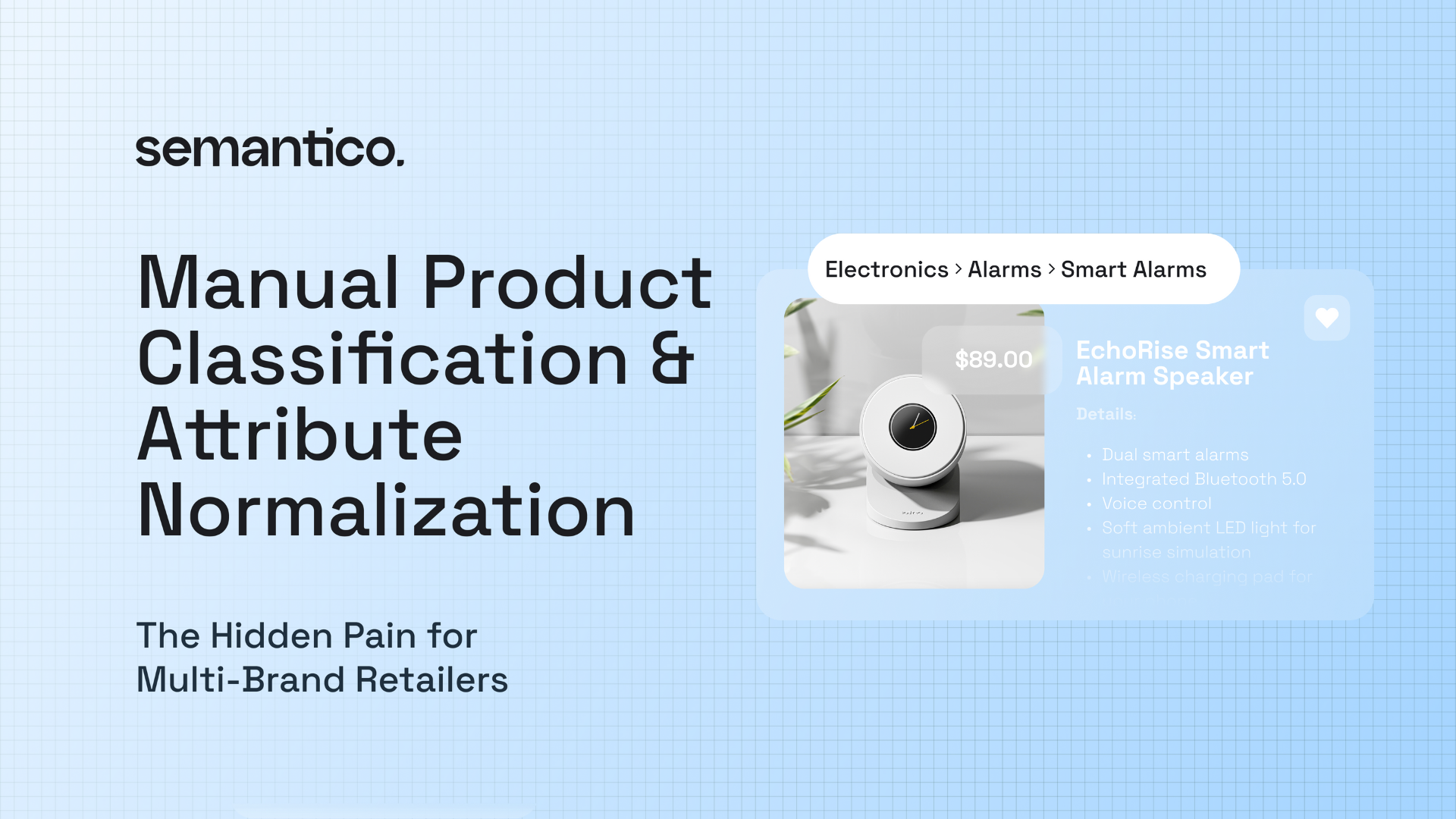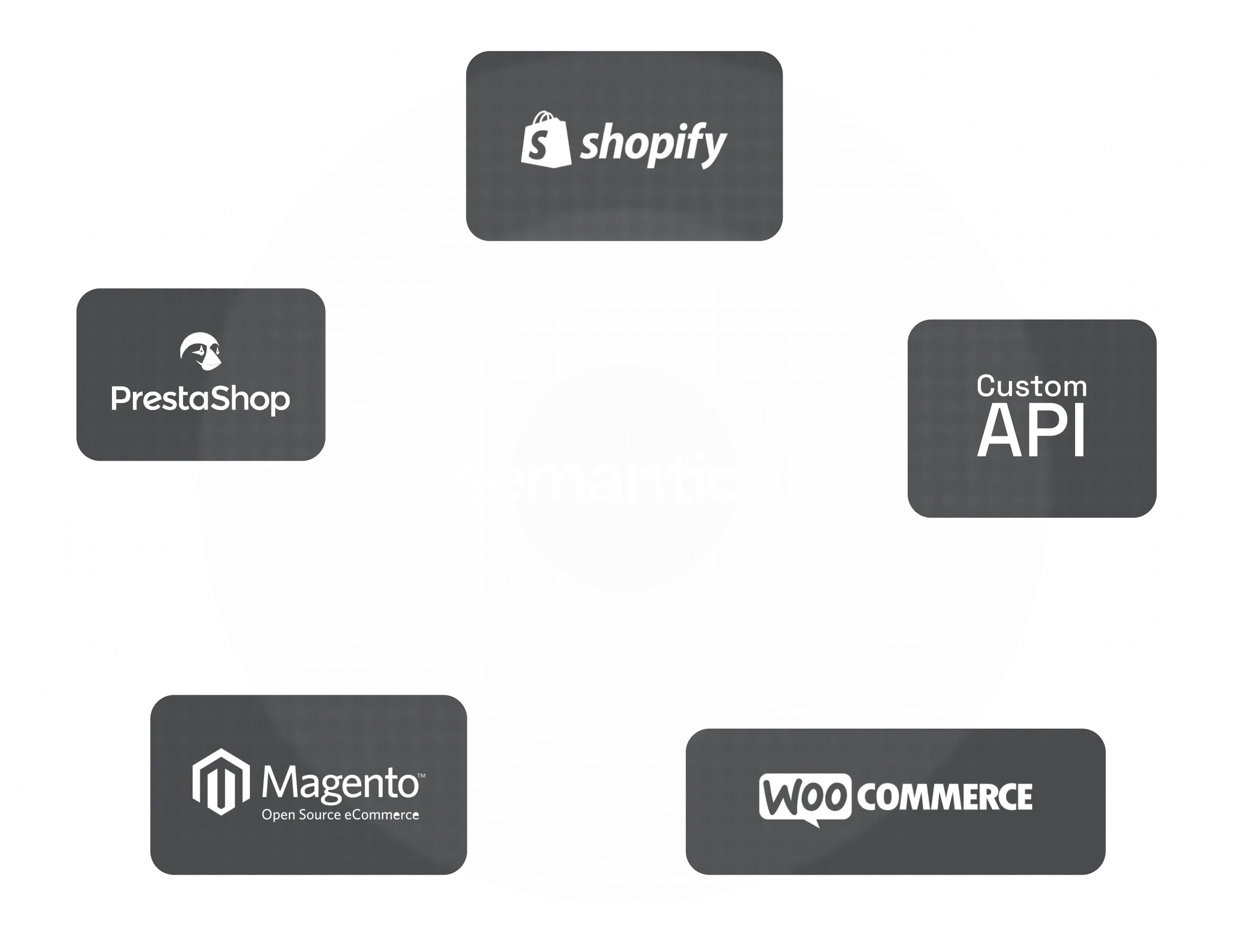Imagine you’re an e-commerce manager at a large multi-brand retailer. You’ve just spent weeks manually reclassifying thousands of products under a new category hierarchy. This meant sifting through each product description to extract details like sizes and units hidden in free-form text, then mapping every item to the right category and normalizing its attributes. It’s tedious, error-prone work – but without it, your website’s filters would break, your SEO would suffer, and customers would struggle to find products.
This scenario is all too common for multi-brand retailers (think of department stores like El Corte Inglés, Wallmart, BestBuy, MediaMarkt), where each brand provides product data in its own inconsistent format. The intensive manual labor of classification and attribute normalization has become a major bottleneck in catalog management.
Why Manual Catalog Work Is Unsustainable
When you carry many brands, inconsistency is the norm. Each brand has its own way of describing products, leading to a myriad of data headaches:
- Different naming conventions: One brand’s “navy blue” might be another’s “midnight blue.” A “Medium” size in one catalog could appear as “M” or a number in another. Such inconsistencies make it difficult to standardize attributes, and they break your site’s filters (shoppers can’t filter by “Blue” if half the products are tagged “Navy” instead).
- Varying categories and taxonomies: What one vendor calls “Women’s Dresses” might be “Ladies’ Formalwear” for another. Without a unified category schema, your site ends up with fragmented, overlapping categories that confuse shoppers.
- Diverse attribute formats (or missing data): Sizes might be listed as “L”, “Large”, or “42” depending on the brand. Units of measure can differ (cm vs. inches). Some listings omit key info like materials or dimensions entirely. This patchwork of formats and gaps wrecks product data consistency and makes it hard to compare items.
All these issues have real business impact. Shoppers rely on consistent categories and attributes to filter and search; if those are messy, they can’t find what they want. The result? Confusing or broken product filters and poor search results, leading customers to give up. Even more, misclassified or inconsistently described products tend to rank poorly on search engines, hurting your organic traffic. As one industry analysis put it, even small errors in product categorization can hurt search performance, frustrate customers, lead to missed sales, and push shoppers toward better-organized competitors. In short, disorganized product data means lost revenue. Teams often try to fix these issues by brute force – dumping data into spreadsheets, manually editing titles and fields, and repeatedly cleaning up imports. But this manual cleanup doesn’t scale and burns countless hours. It also introduces human error and slows down how fast you can get new products live on your site.
(Image suggestion: Consider inserting a visual here illustrating a messy product data example vs. a cleaned, structured version – for instance, a screenshot of a product listing before and after attribute normalization.)
The High Cost of “Catalog Chaos”
For multi-brand retailers, the “catalog chaos” tax shows up in multiple ways:
- Poor customer experience: If products are miscategorized or attributes aren’t standardized, customers face a frustrating experience with mismatched results and unusable filters. Confused shoppers are less likely to convert into buyers – they might abandon the search or, worse, head to a competitor’s site that’s easier to navigate.
- SEO and discoverability losses: A product buried in the wrong category or lacking standard keywords is harder for Google to surface. Inconsistent or incomplete attributes can lead to thin or irrelevant content, undermining your SEO efforts. Simply put, if your product data isn’t clean and structured, you’re leaking organic search traffic.
- Slower time-to-market: Every time new SKUs arrive, your team must manually map them to categories and clean up their specs. This slows down product launches. A messy taxonomy can delay updates and expansions – you become less agile in responding to trends or onboarding new lines.
- Operational drag and costs: Maintaining spreadsheets and fixing data by hand is not only tedious; it’s expensive. Highly skilled e-commerce data teams end up doing low-value copy-paste tasks. This is time that could be spent on strategic work (like improving merchandising or analyzing sales) instead of firefighting data issues. The inefficiency grows with catalog size – if you double your SKUs, the work more than doubles.
Industry research underscores these costs. Misclassifying even a small percentage of products can translate into significant lost revenue over time. In an era where speed and accuracy in e-commerce are crucial, relying purely on manual processes is untenable. So how can retailers fix this catalog chaos without throwing more people at the problem?
Turning to AI for Scalable Categorization & Normalization
Leading retailers are discovering that artificial intelligence can do the heavy lifting that used to require armies of catalog managers. Modern AI, trained on vast amounts of product data, is exceptionally good at understanding product text and images – and using that understanding to apply consistent structure. Here’s how AI can transform your catalog operations:
- Automatic product categorization: AI can analyze a product’s title, description (even images) and accurately slot it into your category taxonomy. Instead of a human deciding if a “beach tote” belongs under Accessories vs. Luggage, an AI model can make that call in milliseconds – and do it consistently at scale. This ensures every product, new or old, is placed in the right category without manual guesswork. In fact, retailers have used AI tagging to organize items into unified categories and saw immediate improvements in site navigation and search.
- Attribute extraction and standardization: Those messy details like sizes, colors, and materials can be automatically extracted from text or images and normalized. For example, an AI can learn that “Light Blue” and “Sky Blue” should both map to your standard “Blue” color attribute. It can convert all size values to a single format, or ensure units of measure are consistent (convert 2.5kg to 2500g if needed, for instance). By harmonizing attributes across brands, AI makes your filters work smoothly and your product specs uniform. One AI solution even leverages a fashion-specific taxonomy to enrich and align product attributes automatically – something that would be Herculean to do by hand for thousands of SKUs.
- Filling in the gaps: Beyond cleaning what’s there, AI can also generate missing information. If a vendor’s data feed lacks a proper product description or omits a material, AI language models can draft a description or infer likely attributes (e.g. guessing fabric from context or images) in a consistent tone. This means no product ever goes live with placeholder text or blank fields – everything is enriched to meet your standards. The result is a more complete, SEO-friendly listing for every item.
- Real-time scalability: Perhaps most importantly, AI-driven processes operate in seconds and can handle huge volumes simultaneously. Whether you’re onboarding 100 new products or 10,000, the AI will categorize and normalize each one just as easily. This reduces time-to-market dramatically – some retailers report getting products live 10× faster after deploying AI for data enrichment. By cutting out repetitive manual steps, your team can launch new collections or update catalogs in a fraction of the time, even during peak seasons.
The benefits of this automation are striking. You get clean, consistent product data at scale, which leads to better shopper experience and higher conversion. Filters and search work perfectly, so customers find items faster (boosting discoverability and sales). New SKUs flow through the pipeline quickly without bottlenecks. And your internal teams are freed from grunt work to focus on strategy and analysis. In one case, a fashion retailer using AI saw a 90% increase in productivity of their catalog team and a significant lift in search result quality, all while expanding their catalog rapidly.
From Chaos to Order: How Semantico’s AI Solves It
This is where Semantico’s AI-powered catalog solution comes into play. We designed it specifically to tackle the pains of multi-brand product data management. Instead of wrestling with spreadsheets and manual edits, you can let our AI platform handle the classification and normalization end-to-end:
- Automatic category mapping: Feed the AI a product (even just an SKU or a rough title), and it will classify that product into your category tree instantly. No matter how each supplier or brand labeled their item, Semantico’s system understands the context and picks the correct category in your hierarchy. This ensures your entire catalog conforms to a single, logical taxonomy without you lifting a finger. As our platform’s positioning statement highlights, we provide “automatic categorization across your catalog” – a core feature to eliminate manual sorting.
- Attribute normalization at scale: Semantico’s engine pulls out all the key attributes (size, color, dimensions, material, etc.) from your product data and normalizes the names and values according to your standards. You define the format or naming conventions you prefer, and the AI makes sure every product follows them. For example, if you want all shoe sizes in EU sizing or all clothing sizes spelled out (“Medium” instead of “M”), the system will output it that way consistently. This capability, described as “attribute normalization so names/values stay consistent,” is built-in. Say goodbye to the patchwork of “Blue/BLU/Navy” – with AI, it’s uniformly “Blue” across your entire catalog.
- Seamless data enrichment: Beyond categories and basic specs, Semantico can auto-generate enhanced content like product descriptions, SEO-friendly titles, and even translate them for different locales while preserving your brand voice. It’s like having an army of content writers and data cleaners who work in seconds. All product information gets structured into the right sections (titles, bullet points, specs, etc.), perfectly formatted for your site or channels. One simple input (like an EAN code or a supplier sheet) results in a complete, enriched listing ready to publish. This full semantic understanding is what makes Semantico a “semantic engine” for e-commerce catalog data rather than just another tool.
- Integration and scalability: Our solution plugs into your existing workflow – whether you use a PIM, eCommerce platform, or custom database. With one click, you can export the cleaned and normalized data to your store (Shopify, Magento, etc.), with proper field mapping and no CSV headaches. The system is built to handle multi-language, multi-channel catalogs, ensuring that no matter how large or diverse your product portfolio gets, your data remains consistent. By automating the slowest steps (categorization, attribute cleanup, content generation), Semantico lets your team spend time reviewing and refining the AI outputs instead of doing them from scratch.
The upshot is a dramatic reduction in manual workload and a massive improvement in data quality and speed. Your products go live faster (often the same day they’re acquired), with rich content and accurate attributes from the start. This means better SEO performance (since pages are complete and well-structured on day one), improved conversion (customers see clean, correct information), and fewer returns or support issues (because product details are accurate and standardized). As a bonus, your internal teams can redirect their energy to growth projects instead of catalog drudgery.
Manual classification and attribute normalization might have been the only option in the past, but today it’s a competitive liability. In the fast-paced world of multi-brand e-commerce, relying on spreadsheets and human effort to organize product data will leave you lagging behind. The pain is real – we’ve all felt it – but so is the solution. AI-powered catalog management is here, and it’s proven to work. It brings order to the chaos by ensuring every product is in the right place with the right information, without the massive manual effort.
For e-commerce managers, category managers & data teams at multi-brand retailers, the message is clear: free your catalog from the manual burden. By investing in automation and tools like Semantico, you turn a painstaking process into a streamlined workflow. The result is not only efficiency and cost savings, but also a better experience for your shoppers and a stronger bottom line for your business. In an environment where product data consistency can make or break a sale (or an SEO ranking), adopting an AI-driven approach to classification and normalization is quickly becoming a must-have rather than a nice-to-have.
Don’t let manual data work hold you back. It’s time to let AI do the heavy lifting in product categorization and attribute normalization – so your team can focus on strategy, your customers can find what they need, and your retail business can scale without the growing pains. The era of AI-optimized catalogs has arrived, and it’s turning a once-insurmountable pain point into a new competitive advantage.





